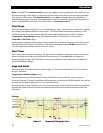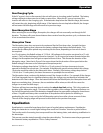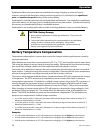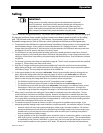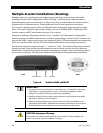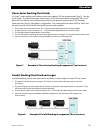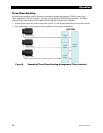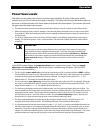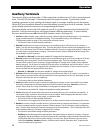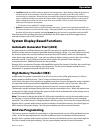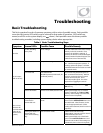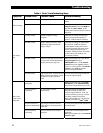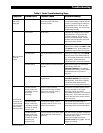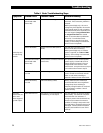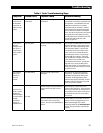
Operation
28 900-0114-01-00 Rev A
Auxiliary Terminals
The inverter’s AUX terminals provide a 12 Vdc output that can deliver up to 0.7 Adc to control external
loads. The AUX LED (see page 11) illuminates when this output is present. Typical loads include
signaling a generator to start, sending a fault a
larm signal, or running a small fan to cool the inverter.
See the GFX Series Installation Manual for more information on hooking up the AUX terminals. See the
system display manual for instructions on programming this feature.
The system display can turn the AUX output on and off. It can also control a series of automatic AUX
functions. There are nine functions, each geared toward a different application. To avoid conflicts,
this menu should be turned
off
when the AGS function is active. (See page 29.)
Cool Fan
enables the AUX output when the inverter reaches a high internal temperature. It is intended to
trigger a small external fan for additional cooling. This is the default setting. See the Warning
Troubleshooting table on page 37 for a description of the fan criteria.
This function does not have settable parameters
.
DivertDC
enables the AUX output to divert excess renewable energy to a DC load, such as a resistor or
heater. The AUX function energizes a relay. Then the relay allows current to flow from the batteries to the
load. (This is illustrated in the GFX Series Installation Manual.) Diversion is triggered by high DC voltage and
is usually used to regulate battery charging. The resistor must be sized to dissipate all of the energy from
the renewable source if necessary.
DivertDC and DivertAC use the same settable DC voltage and time parameters.
DivertAC
enables the AUX function to divert excess renewable energy to an AC load, usually an AC device
powered by the inverter itself. The AUX function energizes a relay. Then the relay allows the excess
current to flow to the AC load. Diversion is triggered by high DC voltage and is usually used to regulate
battery charging. The AC device is usually wired to the output, or load panel, and must be left on. It must
be sized to dissipate all of the energy from the renewable source if necessary. If the inverter shuts down
due to overload, the AUX output will also shut down.
DivertAC and DivertDC use the same settable DC voltage and time parameters.
AC Drop
enables the AUX output whenever the inverter disconnects from an AC source. It can activate a
light (or alarm) to show that the utility grid has failed or that a generator has shut off. Alternately, it could
be used to show that the source is operating.
This function does not have settable parameters.
Vent Fan
enables the AUX output in response to high battery voltage. It can run a small fan to ventilate
the battery compartment to eliminate gases that result from battery charging.
Vent Fan
runs for one
minute. It then stops for a delay period before running again for another minute.
This function has settable DC voltage and settable time delay parameters.
Fault
enables the AUX output when the inverter shuts down due to an error condition (see page 36). It
can activate a l
i
ght or alarm to show that the inverter has failed. With the appropriate devices, it could
send an alarm signal through a radio, pager, or telephone dialer.
This function does not have settable parameters.
This function is not triggered by Phase Loss Error, as Phase Loss Error does not shut down the inverter.
GenAlert
is used as a simple controller for an AC generator with an automatic start feature. The generator
is used to recharge batteries using the inverter’s battery charger. The AUX function is used to energize a
relay. Then the relay activates the remote start/stop circuit on the generator. (This is illustrated in the GFX
Series Installation Manual.) GenAlert is triggered by DC voltage.
This function has settable voltage and time parameters.
GenAlert has the advantage of functioning when the system display is removed. However, it may not
completely charge the batteries and does not have all the advantages of the Automatic Generator Start
(AGS) feature that is found in the system display. For many users, the AGS feature may prove more
useful than GenAlert. GenAlert, however, could be used as a literal “Generator Alert”, a signal to the
user to manually start a generator.



